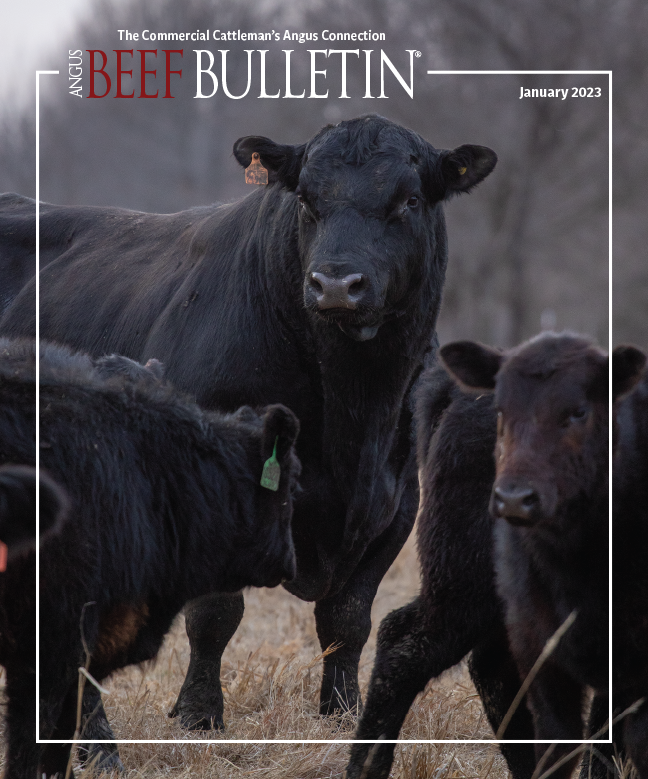
Association Perspective
Why use an Angus bull?
What advantage does an Angus bull pose to a commercial setting? Is it the maternal side — his ability to propagate the mothering ability to raise a heavier weaned calf each year? Do we associate the Angus bull to the longevity and reliability to go out and perform his job day in and day out? Is it due to the market trend of needing more black-hided calves and what that signifies on the rail?
While the answer to each of those questions is yes, one of the most important advantages an Angus bull offers is the ability to continually produce the highest-quality protein in the world. That is exactly the business of each and every cattleman.
With branded-beef programs like Certified Angus Beef, cattlemen have more resources than ever to gain recognition in the marketplace and put premiums in their pockets. What tools are available to help increase your herd’s potential to acquire those premiums? Great question.
The American Angus Association offers a host of tools in the form of expected progeny differences (EPDs) and dollar value indexes ($Values) backed by the millions of data points submitted by Association members and carcass data provided by the commercial industry. For those seeking to use rigorous bull selection to improve their carcass merit, looking for the Targeting the BrandTM logo is an easy way to do so.
The logo — and the standards designating which animals can be associated with it — was developed to not only help the seedstock producer better market his bulls while increasing the demand for Angus, but also to help serve as a guidepost for the commercial cowman seeking the best bull for their needs. A registered Angus bull must meet the minimum marbling EPD requirement of +0.65 and have a grid value index ($G) of +55 or higher to be marketed with the Targeting the Brand logo.
In fiscal year 2022, CAB reached 1.234 billion pounds (lb.) in sales, marking the seventh consecutive year of sales above 1 billion lb. To put that into better perspective, that’s 3.4 million lb. per day of the best beef, produced by the thousands of dedicated ranchers looking to maximize standards for a quality product. For the brand to continue to grow sales, it must first experience growth in supply. The commercial producer’s continued focus on targeting quality has been a key element in this success.
The Targeting the Brand program offers the reassurance that your next bull is going to have the genetic potential to sire calves more likely to qualify for the Certified Angus Beef® (CAB®) brand. As stated before, the benefit of having black-hided calves in the market is apparent, but not all black-hided calves are created equal. The use of the tool is meant to help signify bulls that carry higher genetic merit for carcass quality that correlate to calves with increased potential to meet the 10 specifications for CAB acceptance. When used correctly, it is a helpful instrument for making bull selections.
The most frequently missed specification for CAB acceptance is marbling. As a highly heritable trait, commercial producers can increase the potential of their calves by starting off with a genetic advantage. For the producer retaining ownership, this leads to more profit potential in grid premiums. For the producer merchandising feeder cattle, this opens some additional marketing doors through resources like the AngusLinkSM Genetic Merit Scorecard® (GMS).
The GMS is another tool to be utilized when marketing calves or yearlings through USDA Process Verified Programs to help buyers better understand the genetic makeup of the cattle. The scores are based on the breed composition of the cow herd and the EPDs of the registered Angus bulls properly transferred into that herd’s name. The three scores — Beef, Grid and Feedlot — are provided on a scale of 0 to 200, where a score of 100 represents the industry average. The scorecard will receive the Targeting the Brand logo when the group has met the visual requirements of being predominantly black, has a minimum Grid score of 125, and whose bull battery meets the minimum marbling criteria. The addition of the logo to the GMS signals to potential buyers that those calves have higher potential for CAB acceptance rates.
When it comes time to investigate buying your next bull, many things ultimately must be considered. If this is the end goal you are looking to take your herd to, these are some of the tools the Association recommends to help get you there. Remember to use every tool conveniently at your disposal to make the best buying decision for bulls, as this choice will affect your herd’s potential for years to come.
Not all tools and breeding philosophies are alike, and many experienced producers have taken different paths to get to the same goal. It is important to keep in mind that not every operation should take the same route.
Another tool often overlooked when making buying decisions is reaching out to the regional manager in your area. Regional managers are constantly working on the cattleman’s behalf to help locate the best advantages possible in the industry.
For more information about Targeting the Brand, visit www.cabcattle.com.
Editor’s note: Will Harsh serves as a regional manager covering the states of Alabama, Arkansas, Louisiana and Mississippi. Click here to find the regional manager for your state.

